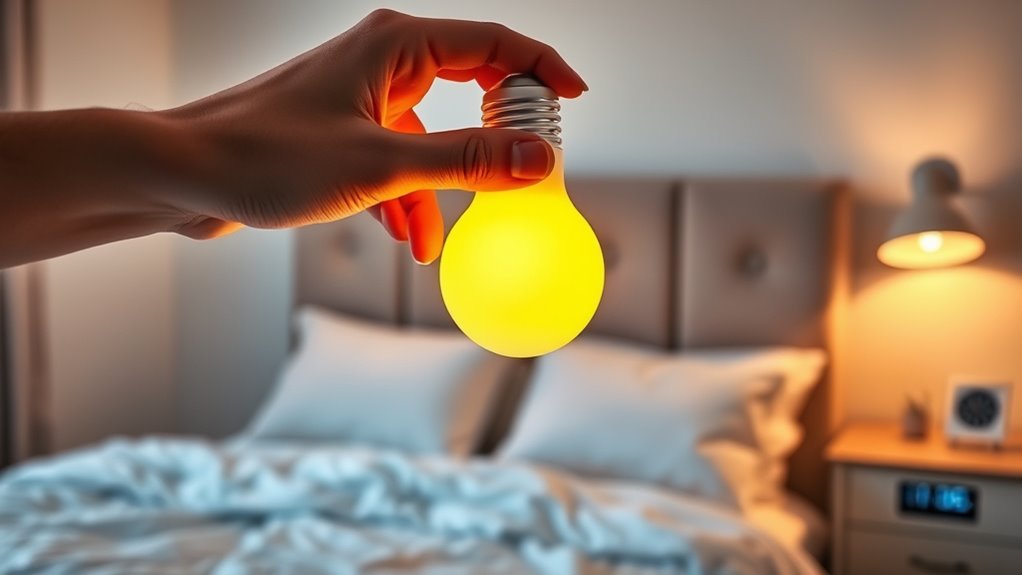Swapping your standard bulbs for circadian-friendly alternatives is an easy way to improve sleep quality. Choose bulbs labeled “circadian” or “biologically optimized,” and consider ones that adjust from cool, blue-toned light in the morning to warm, amber hues in the evening. Install them in key areas like your bedroom and workspace, and set them to dim or change color throughout the day. Keep exploring to learn how to create the perfect lighting setup for restful sleep.
Key Takeaways
- Choose circadian-friendly LED bulbs labeled “biologically optimized” with adjustable color temperature and dimming features.
- Replace cool, blue-enriched bulbs with warm, amber-toned bulbs in evening areas to promote melatonin production.
- Install bulbs in key rooms like bedrooms and living spaces where you spend significant time, adjusting brightness for time of day.
- Turn off or dim blue-rich lights at least an hour before bedtime to reduce melatonin suppression.
- Regularly replace aging bulbs to maintain optimal spectrum, brightness, and prevent flickering that can disrupt sleep.
Understanding the Impact of Light on Your Sleep Cycle
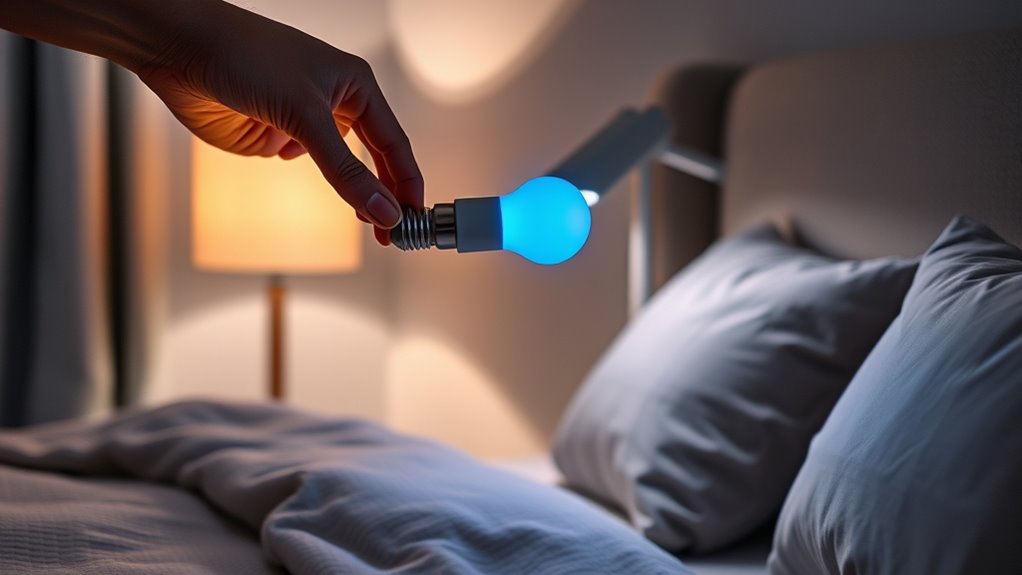
Have you ever wondered how light influences your sleep? It all comes down to melatonin regulation, a hormone that controls your sleep-wake cycle. Exposure to certain light spectrum wavelengths, especially blue light, can suppress melatonin production, making it harder to fall asleep. During daytime, natural light helps keep your circadian rhythm in sync, signaling your body that it’s time to be awake. As evening approaches, reducing exposure to blue light allows melatonin levels to rise, preparing you for sleep. Artificial lighting that mimics natural light spectrum can either support or disrupt this process. Understanding how different lights affect melatonin regulation helps you make smarter choices about your lighting environment, ultimately improving your sleep quality and overall health. The role of light spectrum is crucial in maintaining a healthy sleep cycle. Additionally, controlling light exposure based on light spectrum effects can optimize your circadian rhythm and promote better rest, especially when using vetted indoor lighting options.
Recognizing the Types of Circadian-Friendly Bulbs Available
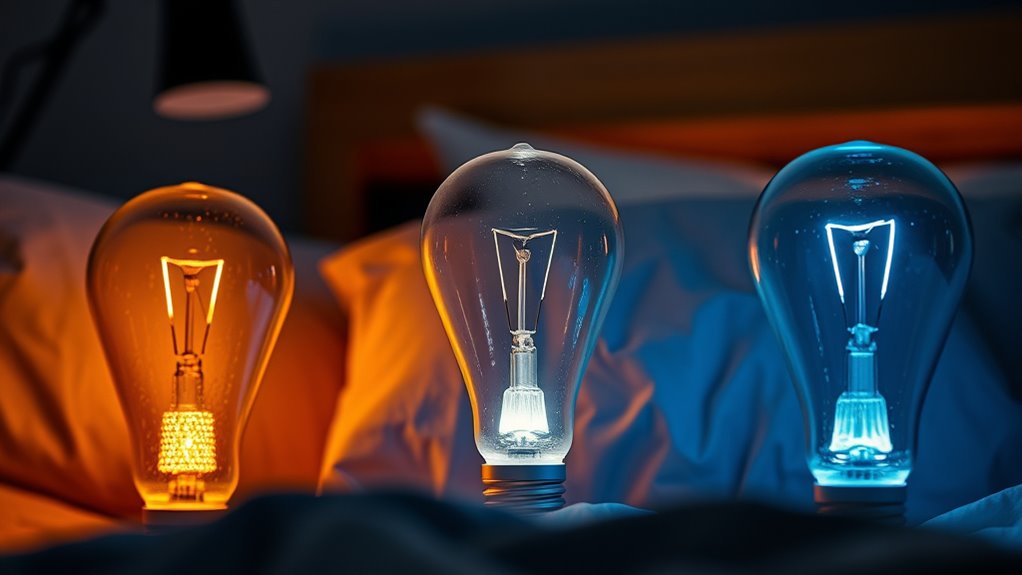
To support your circadian rhythm through lighting, it’s important to recognize the different types of circadian-friendly bulbs available. LED options are popular because they can be customized to emit specific wavelengths of light, mimicking natural daylight or evening levels. When exploring bulb types, look for those labeled as “circadian” or “biologically optimized,” which often offer adjustable color temperatures. Some bulbs are designed to shift from cool, blue-enriched light during the day to warmer, amber hues in the evening, helping regulate your internal clock. Not all LED bulbs are equal, so check for features like dimming capabilities and color control. Understanding these bulb types allows you to make informed decisions that support healthy sleep patterns and overall well-being.
How to Choose the Right Bulbs for Different Rooms
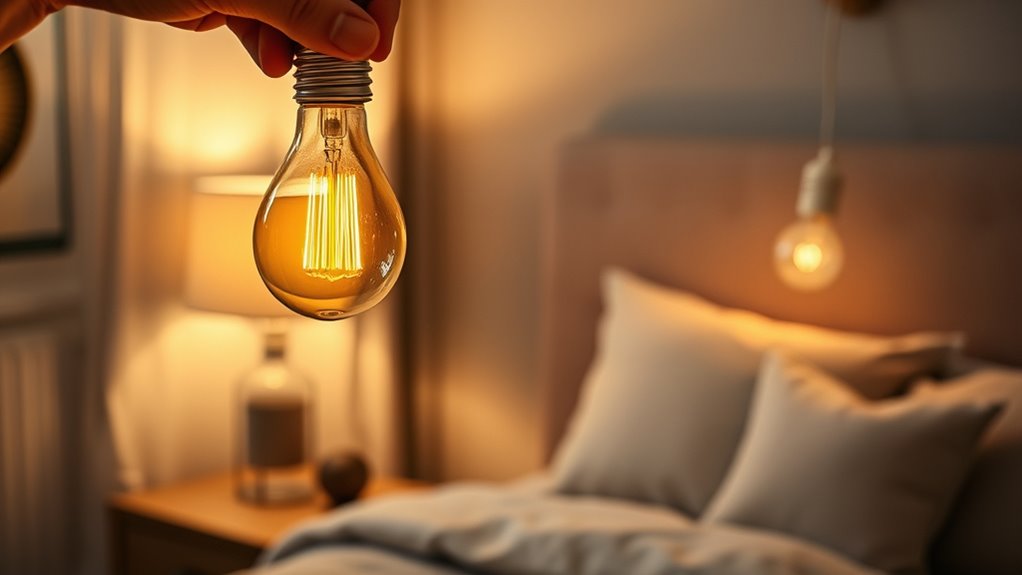
Choosing the right bulbs depends on the room’s function and the mood you want to create. You’ll need to contemplate brightness and color temperature to support your daily routines and circadian health. Additionally, energy efficiency can help you make sustainable choices without sacrificing quality of light. Considering factors like water-resistant features can be beneficial for rooms exposed to humidity, such as bathrooms or kitchens. Incorporating lighting controls can also enhance your ability to adjust light levels and color throughout the day for optimal circadian support. Using bulbs with aesthetic appeal can further complement your decor and create a harmonious environment. Moreover, selecting bulbs with health-conscious designs can promote better sleep patterns and overall well-being.
Room Function and Lighting
Selecting the right bulbs for each room depends on understanding how different spaces are used and the type of lighting that best supports those activities. For areas like the living room or bedroom, consider bulbs with dimming controls to adjust brightness for relaxation or tasks. In kitchens or workspaces, brighter, cooler light helps you stay alert, so choose bulbs with higher color temperature settings. If you want seamless control, opt for smart home integration, allowing you to schedule lighting changes or adjust brightness remotely. Different rooms have unique needs, so tailor your lighting to enhance circadian health and functionality. Properly matched bulbs can improve sleep quality by supporting natural rhythms and creating a comfortable environment for everyday activities. Incorporating lighting design principles ensures your space is both functional and conducive to restful sleep.
Brightness and Color Temperature
Understanding the right brightness and color temperature for each room helps create an environment that supports both function and well-being. For bedrooms, opt for lower brightness levels and warmer color temperatures (around 2700K) to promote relaxation. In workspaces, higher brightness and cooler temperatures (around 4000K-5000K) boost alertness. Living areas benefit from adjustable lighting, blending warm and cool tones as needed. Proper lighting can also support circadian health, ensuring your environment aligns with natural light patterns. Here’s a quick guide:
| Room Type | Recommended Brightness & Color Temperature |
|---|---|
| Bedroom | Low brightness, warm (2700K) |
| Office/Study | Bright, cool (4000K-5000K) |
| Living Room | Moderate brightness, adjustable, mix of warm and cool |
| Bathroom | Bright, neutral (3000K-4000K) |
Energy Efficiency Considerations
To maximize energy efficiency, it’s important to pick the right bulbs for each room based on their specific lighting needs. Opt for LED bulbs, which offer significant energy savings compared to traditional incandescent bulbs. They use less power and last much longer, boosting bulb longevity and reducing replacement costs. In high-traffic areas like kitchens and hallways, choose bulbs that are durable and energy-efficient. For bedrooms and living rooms, select bulbs with adjustable brightness and color temperature to support circadian rhythms while conserving energy. Pay attention to lumens rather than watts to ensure adequate lighting without overuse. By making smart bulb choices, you’ll enjoy lower energy bills and longer-lasting lighting solutions that align with your circadian health goals.
Simple Steps to Swap Out Standard Bulbs in Your Home
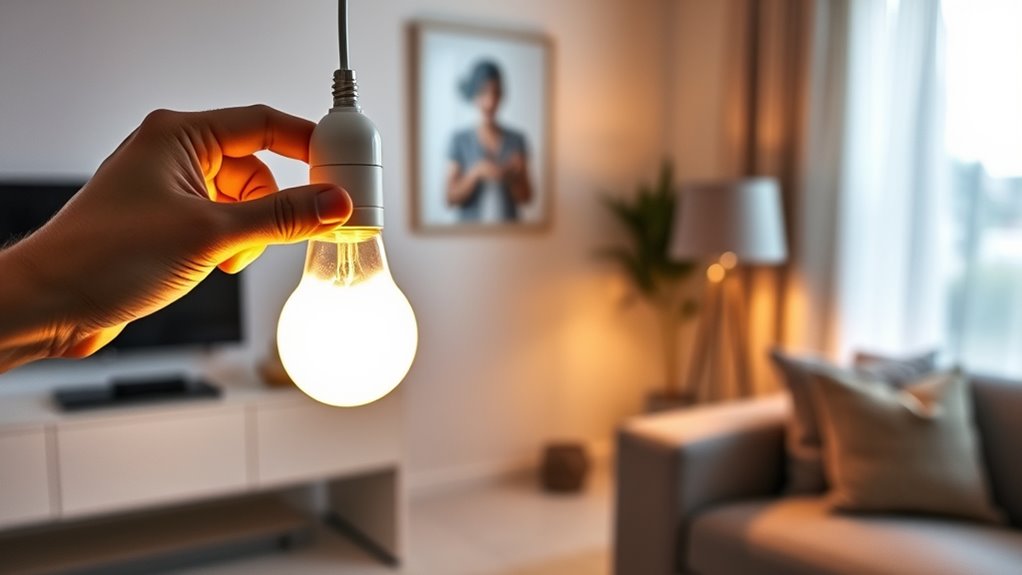
Swapping out standard bulbs is a straightforward way to improve your home’s lighting. First, identify the right bulbs for each room, considering their brightness and color temperature. Then, replace the old bulbs carefully and test each one to guarantee they work correctly.
Identify Appropriate Bulbs
Have you ever wondered how to choose the right bulbs to support your circadian lighting goals? Start by checking the bulb lifespan—long-lasting options save you replacements and hassle. Next, consider color rendering; look for bulbs with a high Color Rendering Index (CRI) to ensure natural, vibrant light that aligns with your body’s rhythms. For circadian benefits, opt for bulbs that emit warmer, dimmable light during evening hours and cooler, brighter light during the day. Avoid bulbs with poor color rendering, which can distort how colors appear and disrupt your mood. Pay attention to labels indicating circadian-friendly features or adjustable color temperature settings. Selecting the right bulbs now sets a solid foundation for creating a sleep-friendly environment in your home.
Replace and Test Properly
Before replacing your bulbs, turn off the power to avoid any electrical mishaps. Carefully remove the existing bulb, noting its lamp placement for consistent lighting. Choose a new bulb with the appropriate circadian-friendly spectrum. Install it securely and turn the power back on. To ensure proper functioning, test the bulb by observing its brightness and color temperature during different times of day. Proper lamp placement can enhance effectiveness, so position bulbs where you spend most time. Keep in mind, bulbs have a limited lifespan; replacing them before they dim guarantees consistent circadian benefits. Here’s a quick reference:
| Step | Action | Tip |
|---|---|---|
| 1 | Turn off power | Avoid shocks |
| 2 | Replace bulb | Match lamp placement |
| 3 | Test brightness | Check color temperature |
Regular testing maximizes sleep benefits from your circadian lighting.
Tips for Maximizing the Benefits of Circadian Lighting
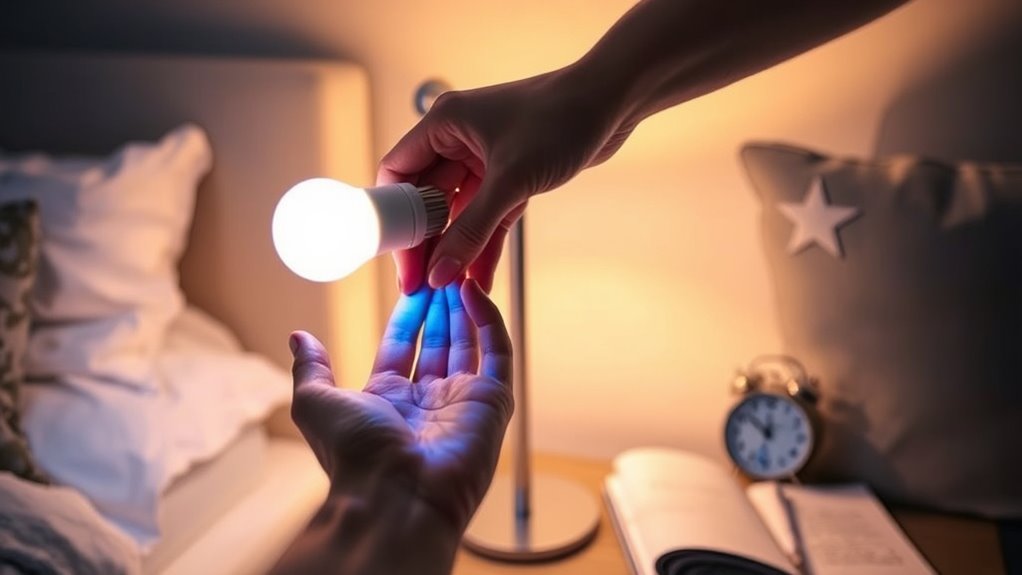
To maximize the benefits of circadian lighting, you should focus on aligning your exposure with natural light patterns throughout the day. Use lighting fixtures that mimic the natural progression of daylight, shifting from cooler, brighter light in the morning to warmer, softer tones in the evening. Pay attention to color perception; choosing bulbs that adjust color temperature helps your body recognize when to stay alert or wind down. Position lighting fixtures strategically in key areas like your workspace and bedroom to support your daily rhythm. Avoid overly harsh or dim lighting that can disrupt your circadian cues. By carefully selecting and timing your lighting, you’ll enhance your sleep quality, mood, and overall well-being.
Additional Lifestyle Changes to Support Better Sleep
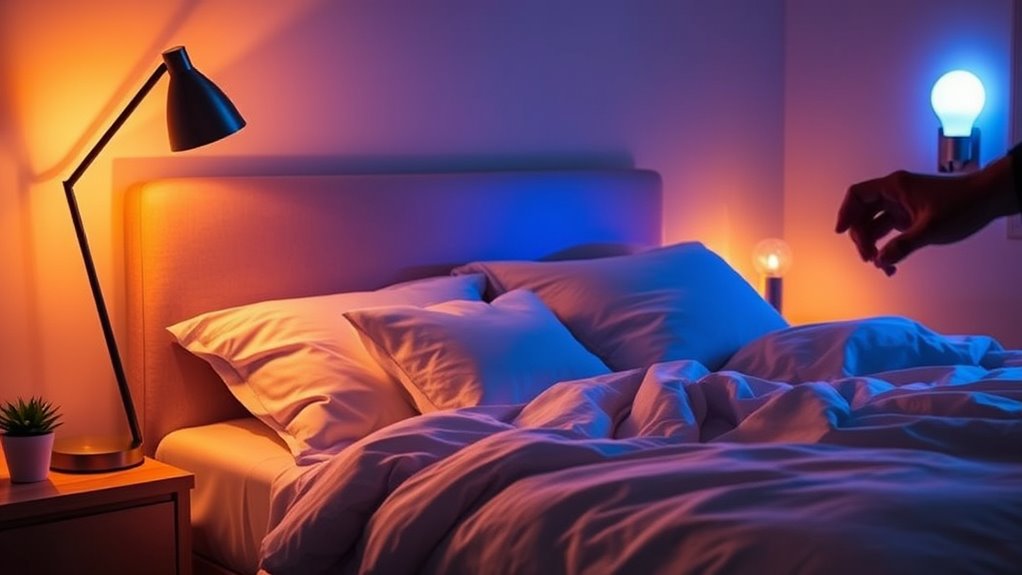
Implementing additional lifestyle changes can substantially enhance your sleep quality alongside circadian lighting. Good sleep hygiene is essential—stick to a consistent sleep schedule, avoid caffeine late in the day, and limit screen time before bed. Incorporating relaxation techniques, like deep breathing, meditation, or gentle stretches, helps calm your mind and body, making it easier to fall asleep. Creating a relaxing bedtime routine signals your body that it’s time to wind down. Keep your sleeping environment cool, dark, and quiet to support restful sleep. Avoid heavy meals or alcohol close to bedtime, as they can disrupt your sleep cycle. By combining these habits with proper lighting, you create a holistic approach that promotes deeper, more restorative sleep.
Monitoring and Adjusting Your Lighting for Optimal Results
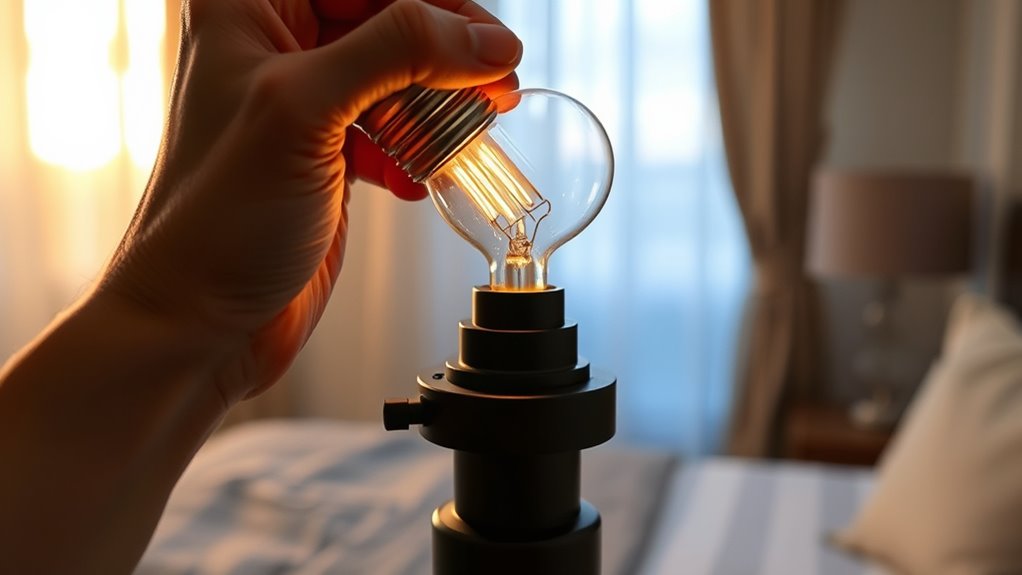
Monitoring and adjusting your lighting setup is essential to guarantee it aligns with your circadian rhythm and supports ideal sleep. Keep an eye on light intensity, ensuring it’s bright enough during the day to energize you but dim enough in the evening to signal winding down. Adjust your bulbs if you notice they’re too harsh or too dim, and consider switching to bulbs with adjustable brightness settings. Regularly evaluate your lighting to prevent overexposure, which can disrupt sleep patterns. Also, be mindful of bulb lifespan; replacing aging bulbs ensures consistent light quality and avoids flickering or reduced effectiveness that could interfere with your circadian cues. Fine-tuning your lighting helps maintain healthy sleep-wake cycles and maximizes the benefits of your circadian lighting setup.
Frequently Asked Questions
Can Circadian Bulbs Be Used With Existing Dimmer Switches?
When considering if circadian bulbs can be used with existing dimmer switches, check the dimmer compatibility first. Not all dimmers work with circadian bulbs, especially LED types. You need to verify your dimmer switch supports LED dimming and is compatible with the bulb installation. If it’s not compatible, you might experience flickering or limited dimming range. Upgrading to a dimmer designed for circadian or LED bulbs can improve performance and ensure proper functionality.
How Long Does It Typically Take to Notice Sleep Improvements?
You might notice sleep improvements sooner than you think—sometimes within just a few days! Usually, after making timing adjustments with circadian lighting, your sleep cycle begins to shift naturally. For best results, give it at least a week, as your body needs time to adapt. Consistent use and proper light exposure during the day can markedly accelerate noticeable improvements in sleep quality.
Are There Any Health Risks Associated With Circadian Lighting?
You might wonder if circadian lighting poses health risks. Generally, using properly designed bulbs reduces eye strain and light sensitivity, but poorly calibrated lighting can cause discomfort or worsen these issues. Avoid overly bright or flickering lights, and make certain the spectrum matches natural daylight. If you experience persistent eye strain or light sensitivity, consult a healthcare professional to prevent potential health risks associated with inappropriate lighting.
Can Children or Pets Be Affected by Circadian Lighting Changes?
You should consider child safety and pet health when changing lighting. Bright or blue-rich lights might disrupt your child’s sleep or harm sensitive eyes, and pets can experience stress or health issues from sudden lighting changes. Always choose age-appropriate, pet-safe bulbs, and make certain the lighting setup doesn’t cause discomfort or confusion. Monitoring how your children and pets react helps protect their well-being while you optimize your lighting for better sleep.
Do Circadian Bulbs Work Effectively in All Types of Light Fixtures?
You might wonder if circadian bulbs work effectively in all fixtures. It depends on fixture compatibility and proper bulb installation. Some fixtures, like enclosed or dimmable ones, may require specific bulbs or adjustments. Always check the bulb specifications and your fixture type before installing to guarantee peak performance. When installed correctly, circadian bulbs can considerably improve your sleep quality by mimicking natural light patterns.
Conclusion
By swapping your standard bulbs for circadian-friendly ones, you’re taking a step toward better sleep—like tuning a vintage radio to the perfect station. Keep experimenting with your lighting, adjusting as needed, and combine these changes with good sleep habits. Remember, just as a lighthouse guides ships safely home, the right lighting can steer your sleep cycle back on course, helping you wake refreshed and ready for the day ahead.
